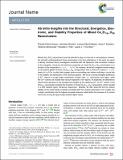Por favor, use este identificador para citar o enlazar a este item:
http://hdl.handle.net/10261/210507COMPARTIR / EXPORTAR:
 SHARE SHARE
 CORE
BASE CORE
BASE
|
|
| Visualizar otros formatos: MARC | Dublin Core | RDF | ORE | MODS | METS | DIDL | DATACITE | |

| Título: | Ab initio insights into the structural, energetic, electronic, and stability properties of mixed CenZr15- nO30 nanoclusters |
Autor: | Felício-Sousa, P.; Mucelini, J.; Zibordi-Besse, L.; Andriani, K.F.; Seminovski Pérez, Yohanna; Prati, R.C.; Da Silva, J.L.F. | Fecha de publicación: | 18-nov-2019 | Editor: | Royal Society of Chemistry (UK) | Citación: | Physical Chemistry Chemical Physics 21(48): 26637-26646 (2019) | Resumen: | Mixed CeO-ZrO nanoclusters have the potential to play a crucial role in nanocatalysis, however, the atomistic understanding of those nanoclusters is far from satisfactory. In this work, we report a density functional theory investigation combined with Spearman rank correlation analysis of the energetic, structural and electronic properties of mixed CeZrO nanoclusters as a function of the composition (n = 0, 1,...,14, 15). For instance, we found a negative excess energy for all putative global minimum CeZrO configurations with a minimum at about n = 6 (i.e., nearly 40% Ce), in which both the oxygen anion surroundings and cation radii play a crucial role in the stability and distribution of the chemical species. We found a strong energetic preference of Zr cations to occupy larger coordination number sites, i.e., the nanocluster core region, while the Ce cations are located near vacuum exposed O-rich regions. As expected, we obtained an almost linear decrease of the average bond lengths by replacing Ce by Zr cations in the (ZrO) nanoclusters towards the formation of mixed CeZrO nanoclusters, which resulted in a shift towards higher vibrational frequencies. Besides, we also observed that the relative stability of the mixed oxides is directly correlated with the increase (decrease) of the Zr d-state (Ce f-state) contribution to the highest occupied molecular orbital with the increase of the Zr content, hence driving the gap energy towards higher values. | Versión del editor: | http://dx.doi.org/10.1039/c9cp04762j | URI: | http://hdl.handle.net/10261/210507 | DOI: | 10.1039/c9cp04762j | Identificadores: | doi: 10.1039/c9cp04762j issn: 1463-9076 |
| Aparece en las colecciones: | (ITQ) Artículos |
Ficheros en este ítem:
| Fichero | Descripción | Tamaño | Formato | |
|---|---|---|---|---|
| priscilla_CeZrO4_nanoalloys_19.pdf | 11,71 MB | Adobe PDF |  Visualizar/Abrir |
CORE Recommender
SCOPUSTM
Citations
4
checked on 21-abr-2024
WEB OF SCIENCETM
Citations
3
checked on 22-feb-2024
Page view(s)
105
checked on 24-abr-2024
Download(s)
143
checked on 24-abr-2024
Google ScholarTM
Check
Altmetric
Altmetric
NOTA: Los ítems de Digital.CSIC están protegidos por copyright, con todos los derechos reservados, a menos que se indique lo contrario.
